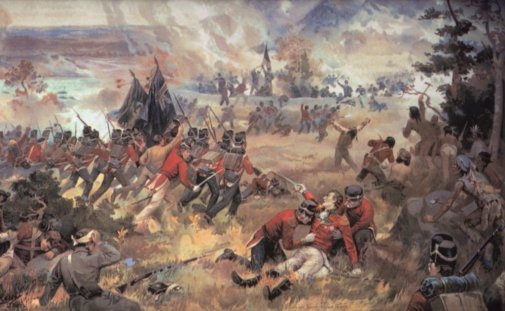In the first year of the War of 1812, the United States hoped to invade and conquer Canada by a four-pronged attack over a number of fronts. One army was to aim at Montreal, another at Kingston, another would cross into the Niagara region, and the last would be launched from Detroit against Amherstburg.

The plans never fully materialized. The American general Hull would be besieged in Detroit and forced to surrender to British General Isaac Brock, General Dearborn dallied in Albany, and the assault on Kingston never materialized. The thrust into the Niagara area did have profound consequences.
In October, General Van Rensselaer, based in Lewiston, New York, planned to cross the Niagara River and seize Queenston Heights. There he would establish a fort from which he could mount further attacks into Upper Canada. To do this, he assembled a force of 900 American army regulars and 2,650 militia men; opposing him was Brock’s contingent of 1,900 British regulars, Canadian militia, and Mohawk natives.
Though the boats carrying the invasion force on October 13 were heavily damaged by British artillery, American troops stormed gamely ashore and, advancing up the hill, took the guns and “spiked” them, putting them out of commission. Their capture of the Heights, and the death from sniper fire of General Brock and his replacement Lieutenant Colonel John Macdonnell, seemed to signal an American victory but British and Canadian reinforcement and a dread of the Mohawks caused nerves to fail and troops refuse to advance to consolidate their position. A bayonet charge and Mohawk war whoops finally brought about an American surrender.
The USA lost 100 killed, 170 wounded, and 835 captured; the defenders lost 21 killed, 85 wounded, and 22 captured. Canada lost a very able general in Brock (that’s him dying in the bottom right of the picture above) but the American invasion had been, not for the first, nor the last, time, thwarted.
The victory is commemorated by the towering Queenston Monument and is memorialized in song. The battle is celebrated in what really ought to be the Canadian national anthem, “The Maple Leaf Forever”, Stan Roger’s ballad “Macdonnell on the Heights”, and the 1959 novelty tune “The Battle of Queenston Heights”, penned in answer to Johnny Horton’s hit single “The Battle of New Orleans”.